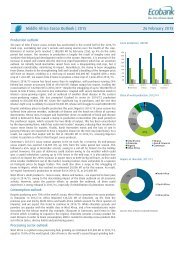www.ebook777.com
Make_Getting_Started_with_Processing_Second_Edition
Make_Getting_Started_with_Processing_Second_Edition
Create successful ePaper yourself
Turn your PDF publications into a flip-book with our unique Google optimized e-Paper software.
166 Getting Started with Processing<br />
<strong>www</strong>.<strong>ebook777.com</strong><br />
An array is created to store a list of elements within a single variable<br />
name. For instance, Example 11-8 on page 155 stores hundreds<br />
of floating-point numbers that are used to set the stroke<br />
value of lines. Arrays can be created from any primitive data<br />
type, but they are restricted to storing a single type of data. The<br />
way to store more than one data type within a single data structure<br />
is to create a class.<br />
The String, PImage, PFont, and PShape classes store more than<br />
one data element and each is unique. For instance, a String can<br />
store more than one character, a word, sentence, paragraph, or<br />
more. In addition, it has methods to get the length of the data or<br />
return upper- or lowercase versions of it. As another example, a<br />
PImage has an array called pixels and variables that store the<br />
width and the height of the image.<br />
Objects created from the String, PImage, and PShape classes can<br />
be defined within the code, but they can also be loaded from a<br />
file within a sketch’s data folder. The examples in this chapter<br />
will also load data into sketches, but they utilize new classes<br />
that store data in different ways.<br />
The Table class is introduced for storing data in a table of rows<br />
and columns. The JSONObject and JSONArray classes are introduced<br />
to store data loaded in through files that use the JSON<br />
format. The file formats for Table, JSONObject, and JSONArray are<br />
discussed in more detail in the following section.<br />
The XML data format is another native data format for Processing<br />
and it’s documented in the Processing Reference, but it’s not<br />
covered in this text.<br />
Tables<br />
Many data sets are stored as rows and columns, so Processing<br />
includes a Table class to make it easier to work with tables. If<br />
you have worked with spreadsheets, you have a head start in<br />
working with tables in code. Processing can read a table from a<br />
file, or create a new one directly in code. It’s also possible to<br />
read and write to any row or column and modify individual cells<br />
within the table. In this chapter, we will focus on working with<br />
table data.



